Key takeaways:
- Subsidized housing, supported by government assistance, aims to provide affordable living options for low to moderate-income individuals and families.
- Community housing fosters connections, enhances family stability, and positively impacts children’s educational opportunities.
- Challenges in accessing subsidized housing include long waiting lists, stigma, and limited available units, making it difficult for many to secure stable housing.
- Proactive strategies such as connecting with local authorities and being flexible with location can help individuals find suitable subsidized housing options.
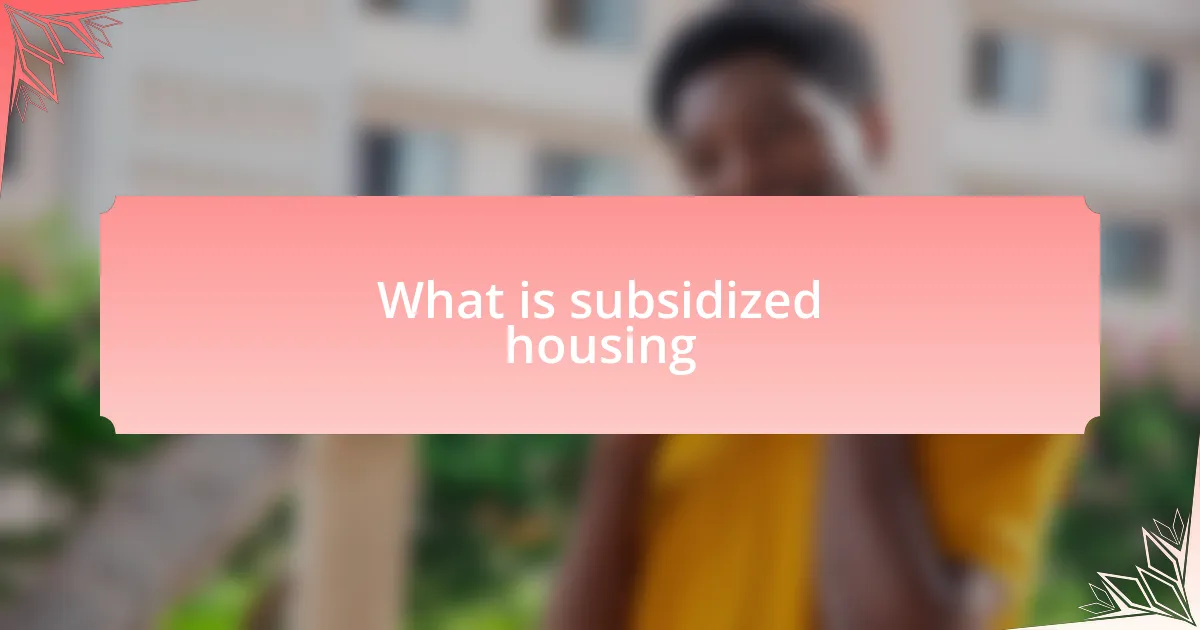
What is subsidized housing
Subsidized housing refers to residential options where government assistance helps reduce rent or make homeownership more affordable for individuals and families with low to moderate incomes. I remember when I first learned about subsidized housing; it struck me how crucial it is in providing stability for those in need. Can you imagine the relief someone must feel knowing they have a secure place to call home?
These housing programs can take many forms, from public housing structures to Section 8 vouchers, which allow tenants to rent within the private market. It’s fascinating to see how these initiatives strive to create diverse communities by ensuring that everyone, regardless of their financial situation, has a fair chance at stable housing. Have you ever considered how much of an impact a supportive living environment can have on someone’s life?
Additionally, the criteria and funding for subsidized housing can vary widely, reflecting the specific needs of each community. When I was volunteering with a local housing nonprofit, I witnessed firsthand the profound difference this support made in the lives of families trying to break the cycle of poverty. It really made me think: what would society look like if everyone had access to safe and affordable housing?
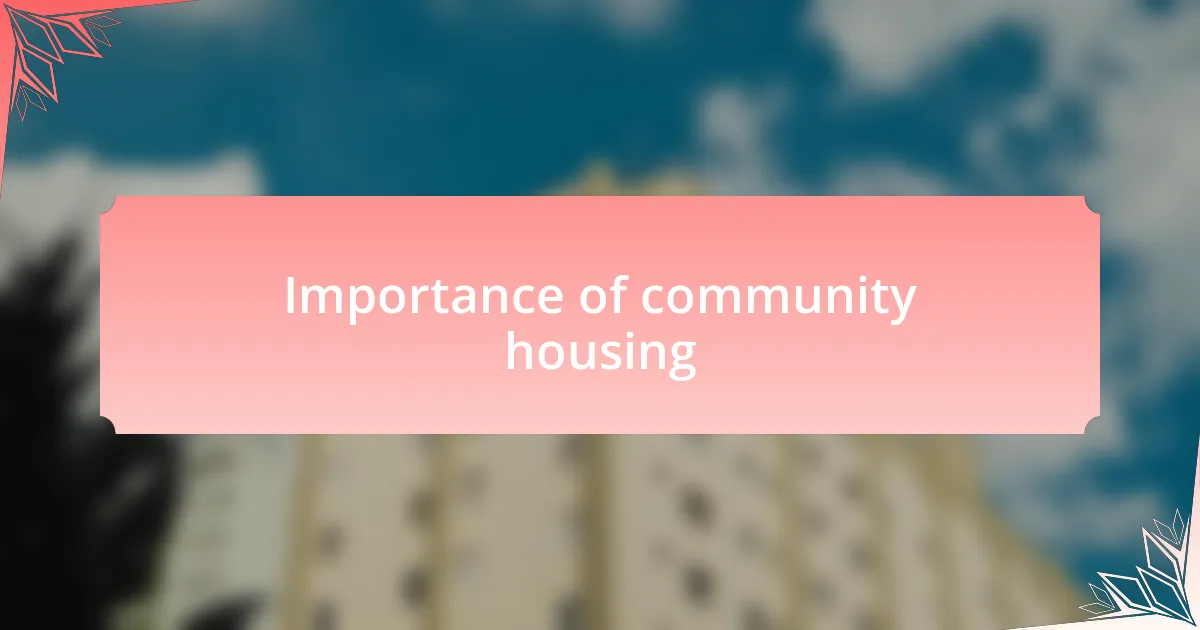
Importance of community housing
Community housing plays a vital role in fostering connections and strengthening neighborhoods. I’ve seen from my own experience that when individuals have a place to live that is not only affordable but also in close-knit communities, it creates a sense of belonging that can be transformative. Have you ever thought about how much more vibrant a community becomes when its residents feel secure enough to invest their time and energy into local initiatives?
Moreover, affordable housing directly impacts family stability and educational opportunities for children. During my time working with a family support organization, I noticed that children in stable housing were more likely to excel in school. It was eye-opening to realize how deeply intertwined housing security and educational achievement are. If families are stressed about unstable housing situations, can they really focus on providing the best for their kids?
Lastly, community housing promotes economic growth and diversity. I remember attending a local town hall meeting where residents shared their stories about how affordable homes attracted small businesses to the area. The ripple effect of providing stable housing can lead to thriving local economies where everyone benefits. Isn’t it inspiring to think about the potential each community holds when housing is accessible to all?
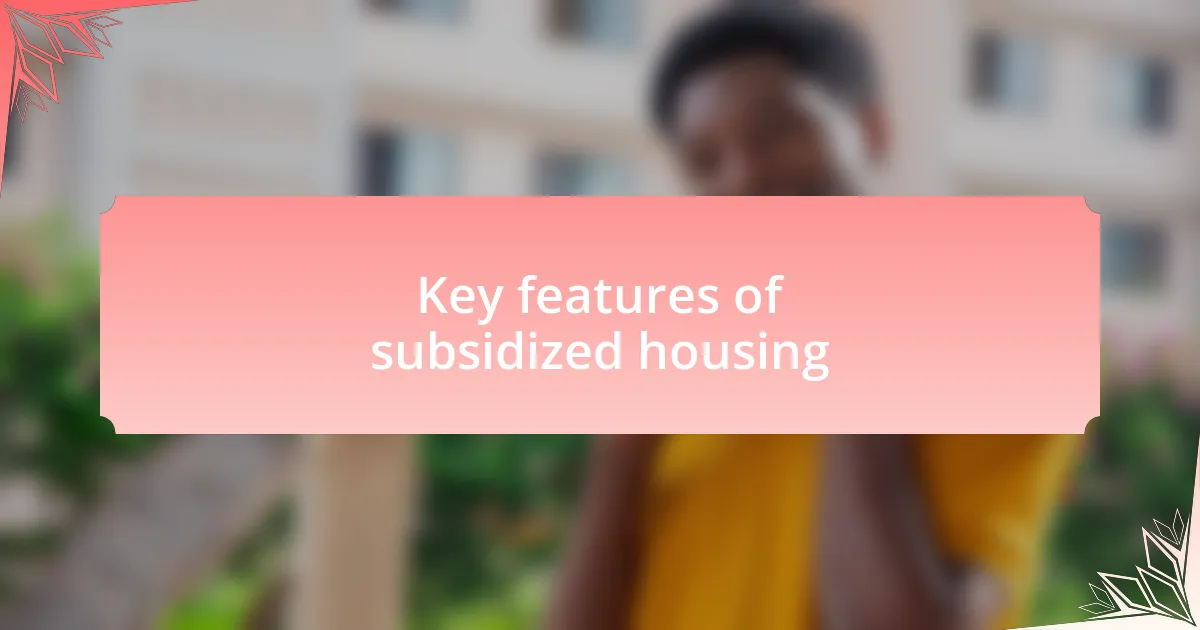
Key features of subsidized housing
Subsidized housing primarily aims to make living spaces affordable for low-income families and individuals. In my experience, I have seen how these programs can ease the financial burden on households, allowing them to allocate funds toward other essential needs like healthcare and education. Wouldn’t it be wonderful if everyone could focus on what truly matters instead of constantly worrying about housing costs?
Another key feature is the support systems often integrated into subsidized housing. I remember visiting a community center in a subsidized neighborhood where residents could access job training and educational resources. This holistic approach empowers residents to improve their circumstances, fostering a sense of agency that many may have thought was out of reach. Don’t you think that having accessible resources right at your doorstep can change lives for the better?
The design and location of subsidized housing are also significant aspects to consider. I’ve encountered developments strategically placed near public transport or essential services, intentionally bridging gaps that often marginalize low-income communities. This thoughtful planning not only makes day-to-day living more convenient but also enhances community engagement. How much more accessible could life be if everyone had easy access to what they need?
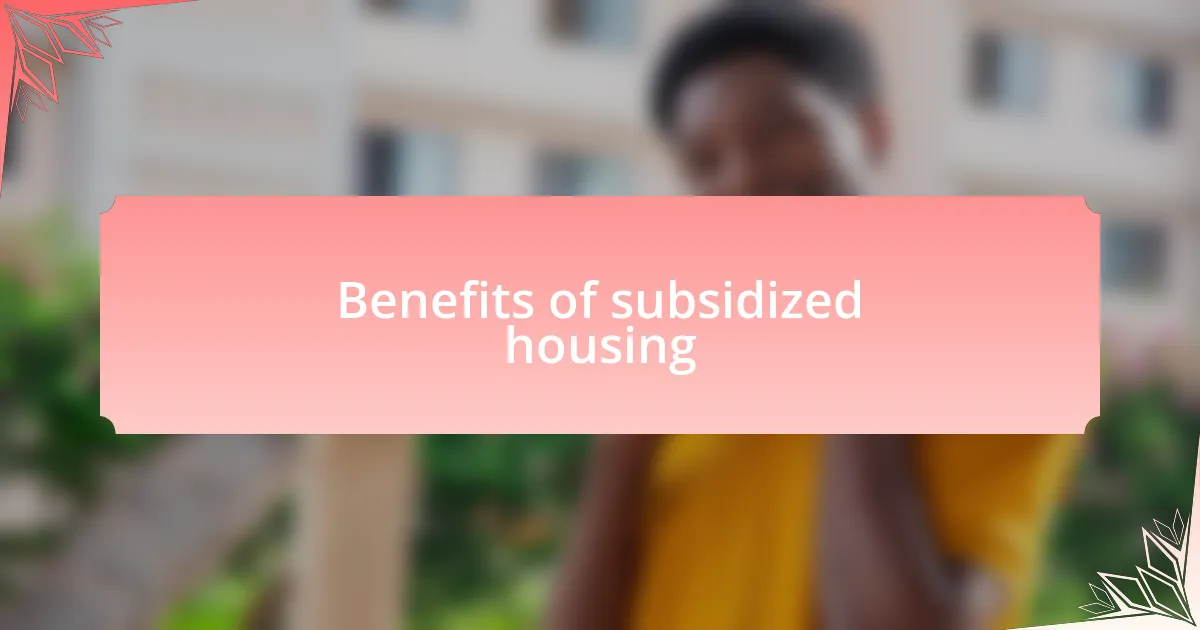
Benefits of subsidized housing
Subsidized housing provides a clear financial advantage by significantly reducing rent costs for low-income families. I’ve spoken to many residents who share how living in these affordable spaces has allowed them to save for emergencies. It’s empowering to think that by lowering housing expenses, families can build a safety net they might not have thought possible.
Additionally, the community aspect of subsidized housing is invaluable. During a community barbecue I attended, I saw neighbors come together, sharing stories and support that you rarely see elsewhere. Isn’t it heartwarming to think that a home can also mean belonging to a tight-knit community where relationships flourish?
Moreover, the stability afforded by subsidized housing can lead to improved mental well-being. I recall a former resident telling me how moving into subsidized housing relieved years of stress from living in unstable situations. Can you imagine how transformative it feels when the worry of eviction fades away, allowing individuals to pursue their dreams with newfound confidence?
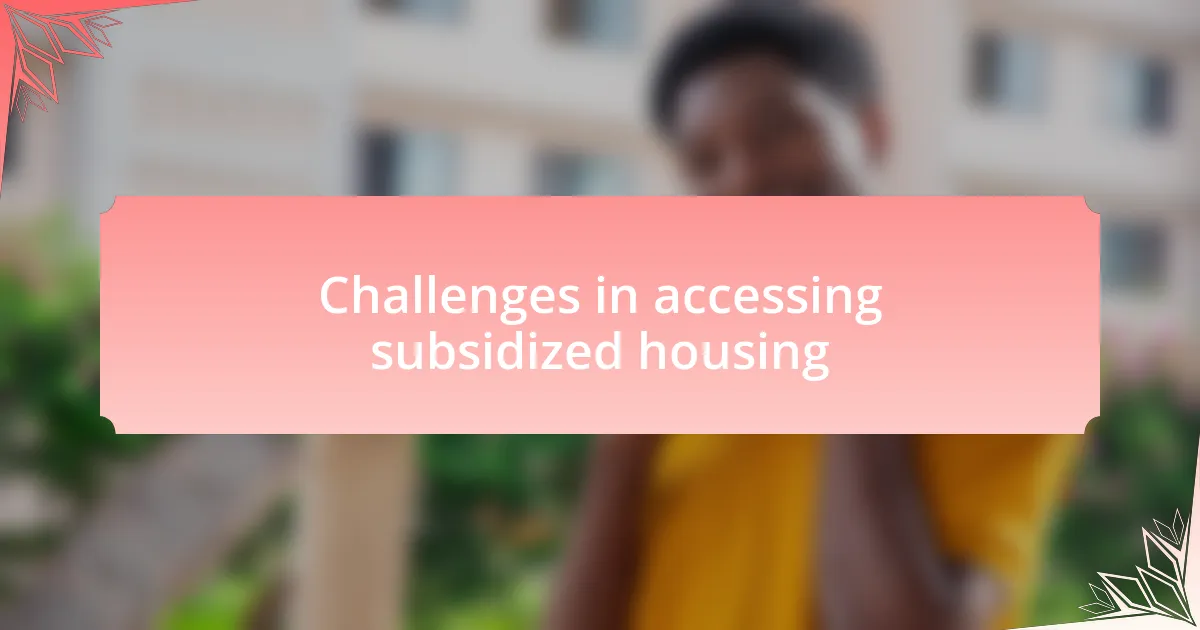
Challenges in accessing subsidized housing
Accessing subsidized housing often feels like navigating a complicated maze. I remember talking to a young mother who had applied multiple times, only to encounter long waiting lists and unclear eligibility criteria. It made me wonder how many people, like her, are left feeling defeated by a system that is supposed to help them.
One of the most significant challenges people face is the stigma associated with living in subsidized housing. I’ve seen it firsthand when a friend of mine faced judgment from acquaintances simply because she was in a housing program. This societal perception can deter those in need from seeking the very support that could change their lives for the better. Why should a helping hand feel like a mark of shame?
Additionally, the lack of available units can be a crushing reality. I recently spoke with a family who had their hopes set on a specific neighborhood, only to find that all the spots were filled. It made me reflect on how frustrating it must be to see the hope of a stable and secure home slip away because of overwhelming demand. How can we expect families to thrive when the options are so limited?
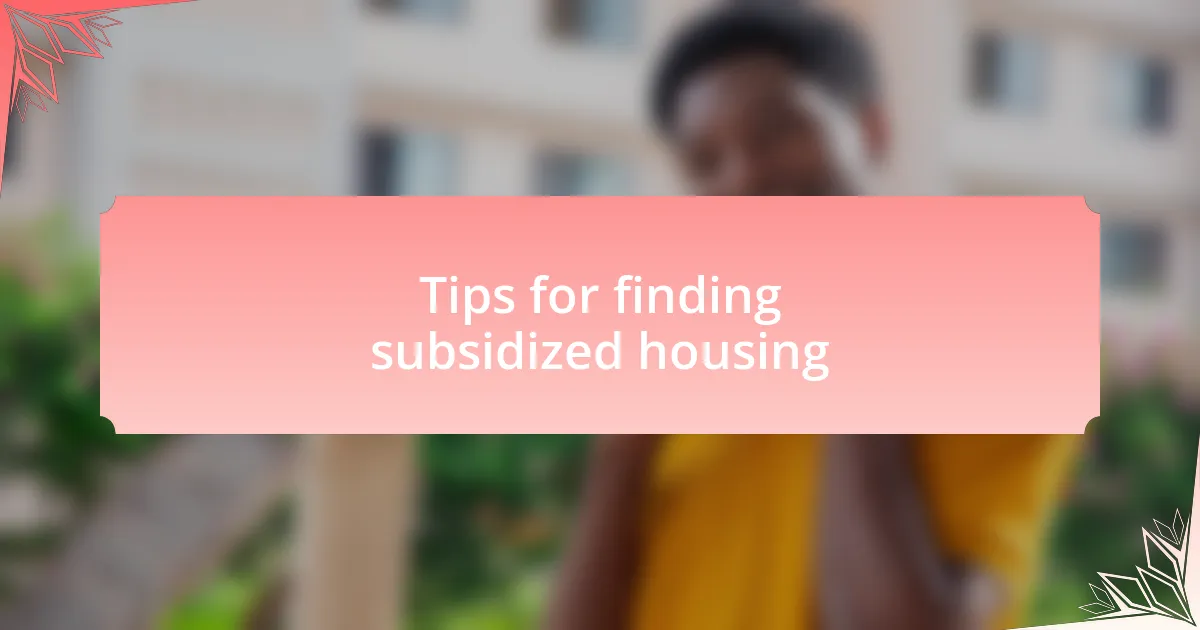
Tips for finding subsidized housing
Finding subsidized housing can sometimes feel like searching for a needle in a haystack, but there are strategies that can help. From my experience, one of the most effective steps is to connect with local housing authorities or nonprofit organizations specializing in housing assistance. I recall when I reached out to a dedicated team in my area; they guided me through the often-overwhelming application process and provided invaluable information about upcoming openings.
Being proactive is key. I often recommend keeping a close eye on local listings and attending community meetings where housing updates are shared. For instance, I once learned about a new subsidized development in my neighborhood simply by attending a town hall meeting. It drove home the importance of staying informed and engaged. How often do we overlook these local resources right at our fingertips?
Moreover, it’s essential to be open about your needs and flexibility regarding location. I spoke with a couple who broadened their search radius and found an unexpected gem in a neighboring town. Their willingness to adapt not only led them to affordable housing but also to a vibrant community they had never considered. What if by expanding your options, you discover a place that feels like home?